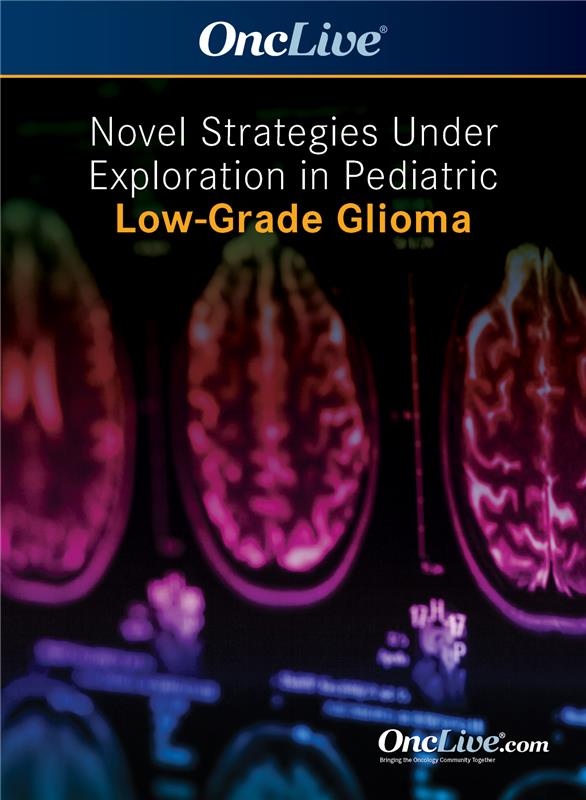Commentary
Article
Supplements and Featured Publications
Tovorafenib Induces Responses in Low-Grade Gliomas, Including Optic Pathway Gliomas
Author(s):
Tovorafenib elicited rapid, clinically meaningful tumor responses in pediatric patients with low-grade gliomas, including those with optic pathway gliomas, regardless of prior MAPK inhibitor status.

Tovorafenib (DAY101) elicited rapid, clinically meaningful tumor responses in pediatric patients with low-grade gliomas, including those with optic pathway gliomas, regardless of prior MAPK inhibitor status, according to findings from the phase 2 FIREFLY-1 trial (NCT04775485) that were presented during the 28th Annual Meeting and Education Day of the Society for Neuro-Oncology.1,2
Among all evaluable patients with low-grade gliomas enrolled in FIREFLY-1 (n = 69), the overall response rate (ORR) per Response Assessment in Neuro-Oncology High-Grade Glioma (RANO-HGG) criteria was 67% (n = 46/69).1 In patients who had received prior MAPK inhibitors (n = 41) and those who were MAPK inhibitor–naive (n = 28), the ORR was 71% and 61%, respectively.
Among all evaluable patients with optic pathway gliomas in the optic pathway glioma subgroup of FIREFLY-1 (n = 39), the ORR per RANO-HGG criteria was 64% (n = 25; 95% CI, 47%-79%).2
Low-grade gliomas are among the most common brain tumors, with an incidence rate of approximately 27.1%.3 In infants, children ages 1 to 4 years, children ages 5 to 9 years, and children ages 10 to 14 years, gliomas are the most common tumor type, at incidence rates of 37.2%, 58.1%, 56.5%, and 48.6%, respectively. Sixty-eight percent of pediatric low-grade gliomas are primarily driven by BRAF and NF1alterations.4
Forty percent of pediatric low-grade gliomas are optic pathway gliomas, of which pilocytic astrocytomas comprise the majority.5 Optic pathway gliomas can be sporadic, presenting throughout childhood, or occur in association with NF1 alterations.6 Sporadic optic pathway gliomas are more likely to progress and cause clinical symptoms or visual impairment, and over 90% of these gliomas require treatment.5
Tovorafenib is an oral, selective, central nervous system–penetrant, type II RAF inhibitor that is active against monomeric and dimeric RAF signaling.1,2
The phase 2 FIREFLY-1 trial is investigating tovorafenib in patients ages 6 months to 25 years with RAF-altered tumors who had received and radiographically progressed on 1 or more prior lines of systemic therapy. Patients could have previously received a MAPK pathway–targeted therapy.
Arm 1 (n = 77), which is fully accrued, was the registrational arm of the trial, and enrolled patients with pediatric low-grade glioma with known activating BRAF alterations, including BRAF fusions and BRAF V600 mutations. Arm 2 (n = 60) was an extension arm that enrolled patients with pediatric low-grade glioma with known activating RAF alterations, including BRAF or CRAF/RAF1 fusions as well as BRAF V600 mutations. Arm 3 is actively enrolling patients with advanced solid tumors with known activating RAF fusions, including BRAF and CRAF/RAF1 fusions.
All patients receive 420 mg/m2 of tovorafenib (with a maximum dose of 600 mg) once weekly in 28-day cycles for 26 cycles, followed by tovorafenib continuation or a drug holiday.
The primary end point of arm 1 of FIREFLY-1 is ORR per RANO-HGG criteria. Secondary end points include safety, ORR per Response Assessment in Pediatric Neuro-Oncology Low-Grade Glioma (RAPNO-LGG) criteria, clinical benefit rate (CBR), time to response (TTR), duration of response (DOR), and progression-free survival. Exploratory end points include ORR and CBR per RANO Low-Grade Glioma (RANO-LGG) criteria.
Tovorafenib in Low-Grade Gliomas
Of the patients with low-grade gliomas enrolled in arm 1, the median age was 8 years (range, 2-21).1 Most patients were male (52%), White (53%), and not Hispanic or Latino (66%). Patients had received a median of 3 prior lines of therapy (range, 1-9), with 22%, 27%, and 51% receiving 1, 2, and 3 or more prior lines, respectively. BRAF fusions were present in 83% of patients, and 73% and 10% of patients had KIAA1549::BRAF fusions and other BRAF fusions, respectively. BRAF V600E mutations were present in 17% of patients.
Low-grade gliomas of the optic pathway, deep midline structures, cerebral hemisphere, brain stem, cerebellum, and other sites were present in 51%, 12%, 8%, 8%, 6%, and 16% of patients, respectively. Sixty percent of patients had received any MAPK inhibitor, and 56%, 10%, and 7% of patients had received a prior MEK inhibitor, a prior BRAF inhibitor, and prior BRAF and MEK inhibitors, respectively.
Antitumor Activity per RANO-HGG Criteria
The CBR in patients with stable disease (SD) of any length of time was 93% (n = 64). In patients who had received prior MAPK inhibitors (n = 41) and those who were MAPK inhibitor–naive (n = 28), the CBR was 37% and 27%, respectively.
The CBR in patients with SD of at least 12 months was 78%. In patients who had received prior MAPK inhibitors and those who were MAPK inhibitor–naive, the CBR was 80% and 75%, respectively.
Best overall responses of complete response (CR), partial response (PR), SD, progressive disease (PD), and not evaluable (NE) were observed in 17%, 49%, 26%, 6%, and 1% of patients, respectively. Twelve percent and 14% of patients had SD lasting over 12 months and 12 months or less, respectively.
The median DOR was 16.6 months (95% CI, 11.6-NR). In patients who had received prior MAPK inhibitors and those who were MAPK inhibitor–naive, the median DOR was 15.1 months (95% CI, 9.0-16.8) and not reached (NR; 95% CI, 11.6-NR), respectively.
The median TTR was 3.0 months (range, 2.6-16.6). In patients who had received prior MAPK inhibitors and those who were MAPK inhibitor–naive, the median TTR was 2.8 months (range, 2.6-16.6) and 5.3 months (range, 2.6-11.1), respectively.
Antitumor Activity per RAPNO Criteria
The ORR was 51% (n = 39) among 76 evaluable patients. In patients who had received prior MAPK inhibitors (n = 45) and those who were MAPK inhibitor–naive (n = 31), the ORR was 49% and 55%, respectively.
The CBR in patients with SD of any length of time was 82% (n = 62). In patients who had received prior MAPK inhibitors and those who were MAPK inhibitor–naive, the CBR was 84% and 77%, respectively.
The CBR in patients with SD of at least 12 months was 57% (n = 43). In patients who had received prior MAPK inhibitors and those who were MAPK inhibitor–naive, the CBR was 56% and 58%, respectively.
Best overall responses of PR, minor response (MR), SD, PD, and NE were observed in 37%, 14%, 30%, 17%, and 1% of patients, respectively. Five percent and 25% of patients had SD lasting over 12 months and 12 months or less, respectively.
The median DOR was 13.8 months (95% CI, 11.3-NR). In patients who had received prior MAPK inhibitors and those who were MAPK inhibitor–naive, the median DOR was 13.8 months (95% CI, 11.3-NR) and NR (95% CI, 8.4-NR), respectively.
The median TTR was 5.3 months (range, 1.6-11.2). In patients who had received prior MAPK inhibitors and those who were MAPK inhibitor–naive, the median TTR was 5.4 months (range, 1.6-11.2) and 5.3 months (range, 2.3-11.0), respectively.
Antitumor Activity per RANO-LGG Criteria
The ORR was 53% (n = 40) among 76 evaluable patients. In patients who had received prior MAPK inhibitors (n = 45) and those who were MAPK inhibitor–naive (n = 31), the ORR was 51% and 55%, respectively.
The CBR in patients with SD of any length of time was 83% (n = 63). In patients who had received prior MAPK inhibitors and those who were MAPK inhibitor–naive, the CBR was 84% and 81%, respectively.
The CBR in patients with SD of at least 12 months was 61% (n = 46). In patients who had received prior MAPK inhibitors and those who were MAPK inhibitor–naive, the CBR was 58% and 65%, respectively.
Best overall responses of PR, MR, SD, PD, and NE were observed in 26%, 26%, 30%, 14%, and 3% of patients, respectively. Eight percent and 22% of patients had SD lasting over 12 months and 12 months or less, respectively.
The median DOR was 14.4 months (95% CI, 11.0-NR). In patients who had received prior MAPK inhibitors and those who were MAPK inhibitor–naive, the median DOR was 12.0 months (95% CI, 8.5-NR) and 16.3 months (95% CI, 8.4-NR), respectively.
The median TTR was 5.5 months (range, 1.6-11.3). In patients who had received prior MAPK inhibitors and those who were MAPK inhibitor–naive, the median TTR was 5.5 months (range, 1.6-11.3) and 5.3 months (range, 2.3-11.0), respectively.
Tovorafenib Response in Patients With Prior MAPK Inhibitor Progression
Per RANO-HGG criteria, 36% and 28% of patients experienced radiographic progression while receiving a prior MAPK inhibitor during any line of therapy and as their most recent treatment, respectively. The ORR in patients who previously received a MAPK inhibitor during any line of therapy and as their most recent treatment was 68% and 74%, respectively.
Per RAPNO criteria, 37% and 29% of patients experienced radiographic progression while receiving a prior MAPK inhibitor during any line of therapy and as their most recent treatment, respectively. The ORR in patients who previously received a MAPK inhibitor during any line of therapy and as their most recent treatment was 57% and 59%, respectively.
Per RANO-LGG criteria, 37% and 29% of patients experienced radiographic progression while receiving a prior MAPK inhibitor during any line of therapy and as their most recent treatment, respectively. The ORR in patients who previously received a MAPK inhibitor during any line of therapy and as their most recent treatment was 50% and 50%, respectively.
Tovorafenib in Optic Pathway Gliomas
Of the patients enrolled in the optic pathway gliomas subgroup of arm 1 (n = 42), the median age was 8 years (range, 2-16).2 Most patients were male (57%), White (57%), and not Hispanic or Latino (69%). Patients had received a median of 3 prior lines of therapy (range, 1-9), with 12%, 26%, and 62% receiving 1, 2, and 3 or more prior lines, respectively. BRAF V600E mutations, KIAA1549::BRAF fusions, and other BRAF alterations were present in 12%, 81%, and 7% of patients, respectively. Sixty-nine percent of patients had received any prior MAPK inhibitor, and 67%, 7%, and 5% of patients had received a prior MEK inhibitor, a prior BRAF inhibitor, and prior BRAF and MEK inhibitors, respectively.
Of 36 evaluable patients, baseline vision in patients’ best eye was normal, mildly impaired, moderately impaired, severely impaired, and profoundly impaired in 25%, 42%, 17%, 8%, and 8% of patients, respectively.
Optic Pathway Glioma Antitumor Activity per RANO-HGG Criteria
The CBR in patients with SD of any length of time and with SD of at least 12 months was 95% (n = 37) and 79% (n = 31), respectively.
Best overall responses of CR, PR, SD, and PD were observed in 18%, 46%, 31%, and 5% of patients, respectively. Fifteen percent of patients each had SD lasting over 12 months and 12 months or less.
The median DOR was 16.8 months (95% CI, 9.0-NR), and the median TTR was 5.5 months (range, CI, 2.6-16.6).
Optic Pathway Glioma Antitumor Activity per RAPNO Criteria
Among 42 evaluable patients, the ORR was 50% (n = 21; 95% CI, 34%-66%). The CBR in patients with SD of any length of time and with SD of at least 12 months was 88% (n = 37) and 60% (n = 25), respectively.
Best overall responses of PR, MR, SD, and PD were observed in 29%, 21%, 38%, and 12% of patients, respectively. Ten percent and 29% of patients had SD lasting over 12 months and 12 months or less, respectively.
The median DOR was 13.8 months (95% CI, 11.3-NR).
Optic Pathway Glioma Antitumor Activity per RANO-LGG Criteria
Among 42 evaluable patients, the ORR was 55% (n = 23; 95% CI, 39%-70%). The CBR in patients with SD of any length of time and with SD of at least 12 months was 90% (n = 38) and 67% (n = 28), respectively.
Best overall responses of PR, MR, SD, PD, and NE were observed in 19%, 36%, 36%, 7%, and 2% of patients, respectively. Twelve percent and 24% of patients had SD lasting over 12 months and 12 months or less, respectively.
The median DOR was 14.4 months (95% CI, 5.8-NR).
Vision remained stable (67%; n = 24) or improved (22%; n = 8) in the best eye of 89% (n = 32) of evaluable patients (n = 36) per visual acuity assessment. By the end of treatment or the data cutoff, vision in patients’ best eye was normal, mildly impaired, moderately impaired, severely impaired, and profoundly impaired in 44%, 25%, 14%, 14%, and 3% of patients, respectively.
Safety in Arms 1 and 2 of FIREFLY-1
Any-grade treatment-emergent adverse effects (TEAEs) occurred in 100% of patients in arms 1 and 2 (n = 137), and grade 3 or higher TEAEs occurred in 63% (n = 86) of patients. The most common grade 3 or higher TEAEs were elevated creatine phosphokinase (CPK; 12%), anemia (11%), maculo-papular rash (8%), pyrexia (4%), fatigue (4%), vomiting (4%), increased aspartate aminotransferase (AST; 3%), and decreased appetite (4%). Headache, upper respiratory tract infection, dermatitis acneiform, epistaxis, paronychia, and pruritus each occurred in 1% of patients.
Any-grade treatment-related AEs (TRAEs) occurred in 98% of patients in arms 1 and 2 (n = 134), and grade 3 or higher TRAEs occurred in 42% (n = 58) of patients. The most common grade 3 or higher TRAEs were elevated CPK (12%), anemia (10%), maculo-papular rash (8%), fatigue (4%), increased AST (3%), decreased appetite (3%), and vomiting (2%). Pyrexia, dermatitis acneiform, paronychia, and pruritus each occurred in 1% of patients.
TRAEs led to treatment discontinuation in 7% of patients (n = 9). The most common TRAEs leading to treatment discontinuation were tumor hemorrhage (n = 3) and decreased growth velocity (n = 2). Furthermore, 24% and 37% of patients experienced TRAEs leading to dose reduction and dose interruption, respectively.
The global, phase 3 LOGGIC/FIREFLY-2 trial (NCT05566795) is investigating first-line tovorafenib vs chemotherapy in patients with pediatric low-grade gliomas.7 The first patient from this trial was dosed in March 2023.
Disclosure: FIREFLY-1 is a trial contracted by Day One Biopharmaceuticals.
References
- Khuong-Quang DA, Nysom K, Landi DB, et al. Clinical activity of RAF inhibitor tovorafenib according to prior MAPK inhibitor treatment in the registrational low-grade glioma arm of the phase 2 FIREFLY-1 (PNOC026) study. Presented at: 28th Annual Meeting and Education Day of the Society for Neuro-Oncology. November 16-19, 2023; Vancouver, Canada.
- Nysom K, Kilburn LB, Leary SES, et al. Clinical activity and safety of the RAF inhibitor tovorafenib in patients with optic pathway gliomas in the registrational pediatric low-grade glioma arm of the phase 2 FIREFLY-1 (PNOC026) study. Presented at: 28th Annual Meeting and Education Day of the Society for Neuro-Oncology. November 16-19, 2023; Vancouver, Canada.
- Ostrom QT, de Blank PM, Kruchko C, et al. Alex’s Lemonade Stand Foundation infant and childhood primary brain and central nervous system tumors diagnosed in the United States in 2007-2011. Neuro Oncol. 2015;16(suppl 10):x1-x36. doi:10.1093/neuonc/nou327
- Ryall S, Zapotocky M, Fukuoka K, et al. Integrated molecular and clinical analysis of 1,000 pediatric low-grade gliomas. Cancer Cell. 2020;37(4):569-583.e5. doi:10.1016/j.ccell.2020.03.011
- Samples DC, Mulcahy Levy JM, Hankinson TC. Neurosurgery for optic pathway glioma: optimizing multidisciplinary management. Front Surg. 2022;9(884250). doi:10.3389/fsurg.2022.884250
- Packer RJ, Iavarone A, Jones DTW, et al. Implications of new understandings of gliomas in children and adults with NF1: report of a consensus conference. Neuro Oncol. 2020;22(6):773-784. doi:10.1093/neuonc/noaa036
- DAY101 vs. standard of care chemotherapy in pediatric patients with low-grade glioma requiring first-line systemic therapy (LOGGIC/FIREFLY-2). ClinicalTrials.gov. Updated December 5, 2023. Accessed December 6, 2023. https://clinicaltrials.gov/study/NCT05566795



























%20(2)%201-Recovered-Recovered-Recovered-Recovered-Recovered-Recovered-Recovered-Recovered-Recovered-Recovered-Recovered-Recovered-Recovered-Recovered-Recovered-Recovered-Recovered.jpg?fit=crop&auto=format)
%20(2)%201-Recovered-Recovered-Recovered-Recovered-Recovered-Recovered-Recovered-Recovered-Recovered-Recovered-Recovered-Recovered-Recovered-Recovered-Recovered-Recovered-Recovered.jpg?fit=crop&auto=format)
